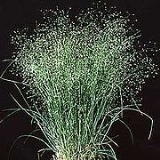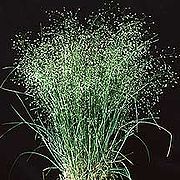
Indian ricegrass
Encyclopedia
Oryzopsis hymenoides is a perennial
cool-season bunchgrass. It is native to western North America
east of the Cascades
from British Columbia
and Alberta
south to southern California
, northeastern Mexico
, and Texas
. In the wild it typically grows 4 to 24 inches (10 to 61 cm) tall and 8 to 12 inches (20 to 30 cm) wide.
It grows in a variety of habitats from desert shrub up to ponderosa pine
forests. It can live in soils from sand to clay, but it does particularly well in sand, where it is the dominant grass growing with sagebrush
and may occur almost unmixed with other plants.
 Indian ricegrass is an important food for livestock and for wild grazers
Indian ricegrass is an important food for livestock and for wild grazers
such as bison
, desert bighorn sheep
, elk
, mule deer
, pronghorn
s, and jackrabbits. For some of these species it is especially vital in late winter, as it produces green shoots earlier than other grasses. The seeds are heavily consumed by many rodent
s and birds, notably mourning dove
s.
This tough grass is known for its ability to reseed and establish itself on sites damaged by fire or overgrazing. Much germination occurs in years with wet Aprils. It is grown in xeriscape
s—cultivar
s are available—and will become quite large if given sufficient space. The open, spangled appearance when in flower or fruit is very attractive, especially in backlight. The flower stalk is commonly used in dry flower arrangements.
, especially when the maize
crop failed. Seed of the ricegrass was gathered and ground into meal or flour and made into bread. Since 2000, the ricegrass has been cultivated in Montana and marketed under the trade name Montina
as a gluten-free grain.
The Utah Section of the Society for Range Management began campaigning for a state grass in the mid-1980s, and after studying many species the field was narrowed to four candidates, Indian ricegrass, bluebunch wheatgrass
, galleta grass
, and Great Basin wildrye
. Indian ricegrass was then selected. The state-grass bill was introduced by Senator Alarik Myrin, a member of the Society, in 1989.
Perennial plant
A perennial plant or simply perennial is a plant that lives for more than two years. The term is often used to differentiate a plant from shorter lived annuals and biennials. The term is sometimes misused by commercial gardeners or horticulturalists to describe only herbaceous perennials...
cool-season bunchgrass. It is native to western North America
North America
North America is a continent wholly within the Northern Hemisphere and almost wholly within the Western Hemisphere. It is also considered a northern subcontinent of the Americas...
east of the Cascades
Cascade Range
The Cascade Range is a major mountain range of western North America, extending from southern British Columbia through Washington and Oregon to Northern California. It includes both non-volcanic mountains, such as the North Cascades, and the notable volcanoes known as the High Cascades...
from British Columbia
British Columbia
British Columbia is the westernmost of Canada's provinces and is known for its natural beauty, as reflected in its Latin motto, Splendor sine occasu . Its name was chosen by Queen Victoria in 1858...
and Alberta
Alberta
Alberta is a province of Canada. It had an estimated population of 3.7 million in 2010 making it the most populous of Canada's three prairie provinces...
south to southern California
California
California is a state located on the West Coast of the United States. It is by far the most populous U.S. state, and the third-largest by land area...
, northeastern Mexico
Mexico
The United Mexican States , commonly known as Mexico , is a federal constitutional republic in North America. It is bordered on the north by the United States; on the south and west by the Pacific Ocean; on the southeast by Guatemala, Belize, and the Caribbean Sea; and on the east by the Gulf of...
, and Texas
Texas
Texas is the second largest U.S. state by both area and population, and the largest state by area in the contiguous United States.The name, based on the Caddo word "Tejas" meaning "friends" or "allies", was applied by the Spanish to the Caddo themselves and to the region of their settlement in...
. In the wild it typically grows 4 to 24 inches (10 to 61 cm) tall and 8 to 12 inches (20 to 30 cm) wide.
It grows in a variety of habitats from desert shrub up to ponderosa pine
Ponderosa Pine
Pinus ponderosa, commonly known as the Ponderosa Pine, Bull Pine, Blackjack Pine, or Western Yellow Pine, is a widespread and variable pine native to western North America. It was first described by David Douglas in 1826, from eastern Washington near present-day Spokane...
forests. It can live in soils from sand to clay, but it does particularly well in sand, where it is the dominant grass growing with sagebrush
Sagebrush
Sagebrush is a common name of a number of shrubby plant species in the genus Artemisia native to western North America;Or, the sagebrush steppe ecoregion, having one or more kinds of sagebrush, bunchgrasses and others;...
and may occur almost unmixed with other plants.
Cultivation

Grazing
Grazing generally describes a type of feeding, in which a herbivore feeds on plants , and also on other multicellular autotrophs...
such as bison
Bison
Members of the genus Bison are large, even-toed ungulates within the subfamily Bovinae. Two extant and four extinct species are recognized...
, desert bighorn sheep
Desert Bighorn Sheep
The Desert Bighorn Sheep is a subspecies of Bighorn Sheep that occurs in the desert Southwest regions of the United States and in the northern regions of Mexico. The trinomial of this species commemorates the American naturalist Edward William Nelson...
, elk
Elk
The Elk is the large deer, also called Cervus canadensis or wapiti, of North America and eastern Asia.Elk may also refer to:Other antlered mammals:...
, mule deer
Mule Deer
The mule deer is a deer indigenous to western North America. The Mule Deer gets its name from its large mule-like ears. There are believed to be several subspecies, including the black-tailed deer...
, pronghorn
Pronghorn
The pronghorn is a species of artiodactyl mammal endemic to interior western and central North America. Though not an antelope, it is often known colloquially in North America as the prong buck, pronghorn antelope, or simply antelope, as it closely resembles the true antelopes of the Old World and...
s, and jackrabbits. For some of these species it is especially vital in late winter, as it produces green shoots earlier than other grasses. The seeds are heavily consumed by many rodent
Rodent
Rodentia is an order of mammals also known as rodents, characterised by two continuously growing incisors in the upper and lower jaws which must be kept short by gnawing....
s and birds, notably mourning dove
Mourning Dove
The Mourning Dove is a member of the dove family . The bird is also called the Turtle Dove or the American Mourning Dove or Rain Dove, and formerly was known as the Carolina Pigeon or Carolina Turtledove. It is one of the most abundant and widespread of all North American birds...
s.
This tough grass is known for its ability to reseed and establish itself on sites damaged by fire or overgrazing. Much germination occurs in years with wet Aprils. It is grown in xeriscape
Xeriscaping
Xeriscaping and xerogardening refers to landscaping and gardening in ways that reduce or eliminate the need for supplemental water from irrigation...
s—cultivar
Cultivar
A cultivar'Cultivar has two meanings as explained under Formal definition. When used in reference to a taxon, the word does not apply to an individual plant but to all those plants sharing the unique characteristics that define the cultivar. is a plant or group of plants selected for desirable...
s are available—and will become quite large if given sufficient space. The open, spangled appearance when in flower or fruit is very attractive, especially in backlight. The flower stalk is commonly used in dry flower arrangements.
Uses
In the past, the grass was a staple food of Native AmericansNative Americans in the United States
Native Americans in the United States are the indigenous peoples in North America within the boundaries of the present-day continental United States, parts of Alaska, and the island state of Hawaii. They are composed of numerous, distinct tribes, states, and ethnic groups, many of which survive as...
, especially when the maize
Maize
Maize known in many English-speaking countries as corn or mielie/mealie, is a grain domesticated by indigenous peoples in Mesoamerica in prehistoric times. The leafy stalk produces ears which contain seeds called kernels. Though technically a grain, maize kernels are used in cooking as a vegetable...
crop failed. Seed of the ricegrass was gathered and ground into meal or flour and made into bread. Since 2000, the ricegrass has been cultivated in Montana and marketed under the trade name Montina
Montina
Montina is a type of flour created from milled Indian rice grass , a type of grass native to the Western United States. Indian rice grass was grown and used by Native Americans as much as 7,000 years ago. The flour is gluten-free. Montina was determined to be gluten-free by Dr...
as a gluten-free grain.
Symbol
Oryzopsis hymenoides, Indian Ricegrass, was officially recognized as the Nevada state grass in 1977 and as the Utah state grass in 1990.The Utah Section of the Society for Range Management began campaigning for a state grass in the mid-1980s, and after studying many species the field was narrowed to four candidates, Indian ricegrass, bluebunch wheatgrass
Bluebunch wheatgrass
Pseudoroegneria spicata is a species of grass known by the common name Bluebunch Wheatgrass. This native western North American perennial bunchgrass is known by the scientific synonyms Elymus spicatus and Agropyron spicatum. The grass can be found from Alaska to Texas. It occurs in many types of...
, galleta grass
Pleuraphis
Pleuraphis is a small genus of grasses in the Poaceae family known generally as galleta grasses. They are sometimes combined with the genus Hilaria. These grasses are native to the southwestern United States and northern Mexico, where they are widespread and common in many types of...
, and Great Basin wildrye
Leymus cinereus
Leymus cinereus is a species of wild rye known by the common names basin wild rye and giant wild rye. It is a common native grass of western North America, including western Canada and the United States from California to South Dakota and Minnesota...
. Indian ricegrass was then selected. The state-grass bill was introduced by Senator Alarik Myrin, a member of the Society, in 1989.

